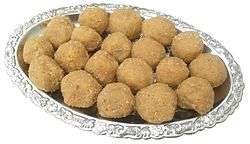Mathura peda
 | |
| Alternative names | Mathura ka Pedha or Pera |
|---|---|
| Course | Dessert, Prasad |
| Place of origin | India |
| Region or state | Mathura, Uttar Pradesh |
| Main ingredients | Khoya, sugar, Milk |
| Variations | Mathura ke pede, Meva vati peda and export quality special peda |
Mathura peda is a North Indian sweet dish that originated from Mathura in India. In North India sweets prepared from mawa (khoya) are very popular and the peda is also a mawa sweet variety.[1] Mathura peda is so famous in India that the term is often used in aphorism like Mathura ka peda au Chhattisgarh ka kheda means "(famous are) the peda sweet of Mathura and hemlet in Chhattisgarh."[2] Mathura acts as a brand name for peda sweet.[3] While visiting Mathura, Mathura ke pede, Meva vati peda and export quality special peda attract the visitors.[4]
Janmashtami feast
In Mathura, the birthplace of Krishna, Mathura ke pede is the favorite offering.[5] These are made by cooking together fresh mawa, milk, sugar and ghee with cardamom powder for added flavour. In India Janmashtami holiday is considered incomplete without the taste of Peda. Every year on this day Peda are prepared to offer to Lord Krishna and breaking the fasting.[6]
Global fame
At various tourist places even outside Mathura also, Mathura ke pede is the famous sweet all along with other Indian sweets like maner ke laddu and Agra ka petha.[7]
The folklore taste
The taste of Mathura ke pede can be seen in Indian folklore also. "Mathura ke pede mohe lave, khilawe ji....."(he gives me the Mathura ka peda to eat) is the famous song among the Sand poojan (worship) songs in India.[8][9]
Android naming controversy
When Google announced for naming the next version of android after an Indian sweet dish, Mathura Peda was one among many other suggested android version names. However, India had no consensus on deciding over a particular name for Android so finally google postponed the proposal for year 2018.[10]
Recipe links
See also
References
- ↑ Sanjeev Kapur. Mithai. Popular Prakashan. pp. Author's Note. ISBN 9788179917121.
- ↑ Madhya Pradesh (India) (1965). Madhya Pradesh district gazetteers, Volume 1. Govt. Central Press. p. 107.
- ↑ John Napier (2013). They Sing the Wedding of God: An Ethnomusicological Study of the Mahadevji ka byavala as Performed by the Nath-Jogis of Alwar. McFarland. p. 175. ISBN 9781476602134.
- ↑ Kavita Kanan Chandra (11 March 2015). "Love and Lord Krishna". Kavita Kanan Chandra. India Currents. Retrieved 24 January 2016.
- ↑ Mattoo, Seema (4 September 2015). "What each region prepares for Krishna on his birthday". Times of India. Retrieved 24 January 2016.
- ↑ Sapana Behl. "Mathura ke Pede". Sapana Behl. Indian Simmer. Retrieved 25 January 2016.
- ↑ Saransh Goela (2015). India on my Platter. Om Books International. pp. Day 83. ISBN 9789383202041.
- ↑ Folk-lore, Volume 13. Indian Publications. 1972. p. 260.
- ↑ Satya Prakash Arya (1975). A Sociological Study of Folklore: Projected Research in Kuru Region (Saharanpur, Muzaffarnagar, Meerut, Bulandshahar, and Bijnor Districts of Western Uttar Pradesh). Indian Publications. p. 102.
- ↑ Mishtik Journo (18 December 2015). "liticians, Laddoo, Chum-chum, Mysore-Pak, Peda, Kheer fight out for Android version name". Mishtik Journo. New Delhi. Faking news. Retrieved 29 January 2016.